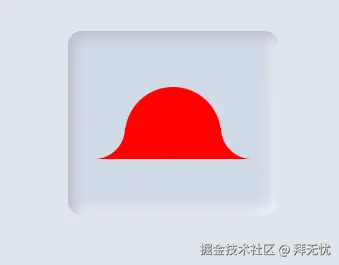这套 CSS 规则的核心是一种非常巧妙的"视觉欺骗"技巧,它通过 主体 和 两个伪元素 的拼接,来创造出带有"反向圆角"的 Tab 凸起效果。
其实现思路可以拆解为以下三个步骤:
1. 主体形状 (.tab-item.active)
- 这是我们能直接看到的、带有文字的 Tab 主体部分。
background-color: red;:这是整个效果能够成立的关键 。这个颜色必须和<body>的背景色(在您的代码中是#e0e5ec)完全一样。当颜色相同时,它就能和页面背景融为一体,产生"浮出"的错觉。您在 Canvas 中看到的red应该是一个为了调试或演示而设置的临时颜色。border-radius: 162px 162px 0 0;:这为主体的左上角和右上角设置了非常大的圆角,而底部两个角则保持直角,构成了 Tab 凸起的基本形状。
2. "反向圆角"的原材料 (.tab-item.active::before, ::after)
- 这是整个技巧最核心、最神奇的部分。我们使用
::before和::after这两个伪元素来分别构造左右两边的"凹陷"圆角。 - 画一个大圆 :我们并没有直接画一个圆角,而是先用
border-radius: 100%和box-shadow: 0 0 0 40px red画了两个巨大的、和背景色相同的实心圆。使用box-shadow而非background是一个聪明的技巧,因为它不占据实际的布局空间,便于定位。 - 精确定位 :通过
position: absolute、bottom: 0和left: -55px/right: -55px,我们将这两个大圆正好放置在了主体部分的左下角和右下角的外侧。
3. 裁剪与拼接 (clip-path)
-
现在我们有了两个紧贴着主体的大圆,但我们实际上只需要每个圆的四分之一来形成那个"凹陷"的弧度。
-
clip-path登场 :clip-path属性就像一把剪刀,可以裁剪掉元素不需要的部分。- 对于左边的
::before,clip-path: inset(50% -10px 0 50%)裁剪掉了圆的"左半部分"和"上半部分",只留下了右下角的四分之一。 - 对于右边的
::after,clip-path: inset(50% 50% 0 -10px)裁剪掉了圆的"右半部分"和"上半部分",只留下了左下角的四分之一。
- 对于左边的
-
完成拼接:这样一来,两个被裁剪后的四分之一圆弧,就完美地与主体的直角底部拼接在了一起,从视觉上"覆盖"了灰色容器的直角,从而形成了流畅的、内凹的反向圆角效果。

xml
<!DOCTYPE html>
<html lang="zh-CN">
<head>
<meta charset="UTF-8">
<meta name="viewport" content="width=device-width, initial-scale=1.0">
<title>纯净版反向圆角Tabs</title>
<style>
@import url('https://fonts.googleapis.com/css2?family=Inter:wght@400;500;600&display=swap');
/* --- 基础和布局样式 --- */
body {
font-family: 'Inter', sans-serif;
display: grid;
place-items: center;
min-height: 100vh;
margin: 0;
background-color: #e0e5ec;
}
/* --- Tab 容器样式 --- */
.tab {
display: flex;
background-color: #d1d9e6;
padding: 50px;
border-radius: 12px;
box-shadow: inset 5px 5px 10px #babecc, inset -5px -5px 10px #f0f2f5;
}
/* --- Tab-Item 默认样式 --- */
.tab-item {
position: relative; /* 为伪元素提供定位上下文 */
padding: 12px 23px;
font-size: 16px;
font-weight: 500;
color: #6d6d6d;
cursor: pointer;
transition: color 0.3s ease;
white-space: nowrap;
border-radius: 12px;
}
/* --- 激活状态下的样式 --- */
.tab-item.active {
width:40px;
height:40px;
color: #1a73e8;
background-color: red; /* 背景色必须与页面背景一致 */
border-radius: 162px 162px 0 0;
transition: color 0.3s ease;
}
/* 隐藏非激活状态下的伪元素 */
.tab-item::before,
.tab-item::after {
content: '';
position: absolute;
bottom: 0;
opacity: 0;
pointer-events: none;
transition: opacity 0.3s ease;
}
/*
* --- 魔法核心: 伪元素拼接反向圆角 ---
* 激活状态下显示伪元素,并赋予它们固定的尺寸和样式
*/
.tab-item.active::before,
.tab-item.active::after {
opacity: 1;
width: 55px; /* 反向圆角尺寸 */
height: 55px; /* 反向圆角尺寸 */
border-radius: 100%;
/* 使用与页面背景色一致的阴影来填充圆形 */
box-shadow: 0 0 0 40px red;
}
/* 左侧反向圆角 */
.tab-item.active::before {
left: -55px; /* 根据尺寸定位 */
clip-path: inset(50% -10px 0 50%);
}
/* 右侧反向圆角 */
.tab-item.active::after {
right: -55px; /* 根据尺寸定位 */
clip-path: inset(50% 50% 0 -10px);
}
</style>
</head>
<body>
<nav class="tab">
<a class="tab-item active"></a>
</nav>
<script>
document.addEventListener('DOMContentLoaded', () => {
const tabItems = document.querySelectorAll('.tab-item');
tabItems.forEach(item => {
item.addEventListener('click', () => {
// 移除所有兄弟元素的 active 类
tabItems.forEach(i => i.classList.remove('active'));
// 为当前点击的项添加 active 类
item.classList.add('active');
});
});
});
</script>
</body>
</html>